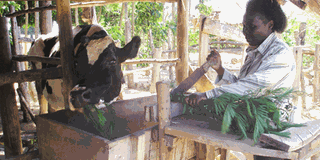Is it economically viable to keep local breeds of cattle?

Both indigenous and exotic breeds of cattle can be reared on a farm to maximise productivity. Proper management and care includes adequate feeding. FILE PHOTO.
What you need to know:
Despite being able to withstand harsh conditions and easier to manage in terms of cost, indigenous cattle breeds yield little quantities of milk and beef, writes Fred Muzaale
It is still a common practice for farmers in Uganda to keep big herds of indigenous breeds of cattle like Nganda, Zebu, Sanga (Ankole) and Boran for milk and beef. In some societies, farmers keep big herds of cattle for prestige without minding about their productivity.
But given the increasing cost of production and ever increasing escalating land scarcity in the country, it has become necessary for farmers to optimally utilise the scarce resources at their disposal to get high returns.
Today, cattle farmers are being advised by the government to change from the old practice of keeping big herds of indigenous cattle breeds from which they get little milk or beef and adopt the practice of keeping a few exotic or cross-breeds from which they can realise higher production in terms of meat and milk.
Mr Bernard Kebba, a veterinary officer in Kayunga district, says that even though indigenous breeds of cattle are easy to manage, they become a burden to a farmer because of the low productivity in terms of milk and beef that he or she gets from them compared to the cost and time that is spent to manage them. He adds that it is true that indigenous breeds of cattle are hardy and able to withstand conditions like different kinds of weather.
Despite these several advantages including having few reproductive problems and being relatively tolerant to tick-borne diseases like the fatal East -coast fever, the productivity of local breeds is extremely low compared to that of cross-breeds or exotic breeds like Jersey, Friesian, Guernsey and Ayrshire.
“A local breed cow can produce about one to four litres of milk a day compared to about 10-15 litres of milk that a cross-breed can produce a day. A 75 per cent cross-breed cow can produce as much as 30-35 litres of milk a day,” Mr Kebba says.
Also, when a farmer wants to sell his or her animals, the one with cross-breeds is likely to earn more money than the one with local breeds. A cross-breed bull can go for between Shs1m and Shs2m compared to a local breed bull, which goes for between Shs 600,000 and Shs 800,000.
Mr James Rwebikire, a Naads programme coordinator and farmer in Kayunga district, states that local cattle breeds have a slower growth rate. An indigenous cow takes at least three to four years before it conceives compared to a cross breed which takes between 16 to 18 months to conceive if well-fed and well managed. This means that a cattle farmer who keeps local breeds takes a much longer period before he or she gets returns from the cattle.
Mr Daniel Ssekamate, a resident of Ntooke village in Kayunga sub-county, Kayunga district, who owns a herd of 20 cows and seven bulls of the indigenous variety says that from the nine cows that he milks, he yields only 18 litres of milk a day.
After setting aside five litres for his family, he sells the rest—13 litres of milk. With each litre at Shs500, he earns a mere Shs 6,500 daily yet he spends about Shs100,000 on treating the animals and paying the herdsman.
He manages his herd on four acres of land on which he has constructed paddocks and also set up a kraal. “I get so little from these animals compared to the amount of money I spend on managing them. I can say that I am like a person keeping cattle for fun,” he reflects.
Ssekamate hopes to sell all the local animals and get at least two Friesian cows from which he hopes to get at least 10 litres of milk from each cow every day.
Another prominent cattle keeper, Mr Godfrey Niyemanya of Kawongo village in Galilaaya sub-county, who owned a herd of 150 animals laments that he lost 46 heads during the recent long drought. This is because his cattle could not get water to drink and pasture to graze as all the grass withered and water sources dried up.
He believes that if he had a smaller herd that he could manage effectively, he could probably not have lost such a big number during the disaster. “I hope to buy cross-breeds but my only fear is that these breeds need a lot of care and the cost to manage them is high compared to the local breeds,” Niyemanya says.
Mr Kebba advises farmers, with indigenous cattle, who want to improve on their productivity to cross them with improved breeds. This would increase their milk production and the size of the animals. This would in turn definitely increase their income.
They should carry out regular spraying or dipping of the cattle to kill ticks with Decatix and Taktic as this will ensure that the animals are not infected with East Coast Fever which reduces milk production. Planting trees in the farm is also important as this ensures that cattle have sheds from which they can rest when the temperatures are high.
Mr Kebba says that even though local breeds are relatively easy to manage than cross-breeds, a farmer who does cattle keeping as a business ought to keep cross-bred cattle.
He also recommends that a calf should be left to feed on colostrum (first milk) for the first seven days as this milk is very crucial for its proper growth. The good management of the calf from two hours after calving to the age of six months is also vital because it is during this period that the mammalian glands are formed.




